Do you have a question about the Yamaha DTX500 and is the answer not in the manual?
Lists included items like power adapter, module stand, and manual.
Explains how buttons, symbols, and messages are represented in the manual.
Highlights key capabilities of the DTX500, such as its tone generator and metronome.
Details safety hazards related to power supply, water exposure, and fire risks.
Covers safe usage regarding electrical outlets, connections, and handling of the instrument.
Advises on avoiding noise, dust, vibrations, and extreme temperatures for proper care.
Warns against turning off power during data writing to prevent data loss.
Details compatibility with pads, input jacks, and drum kit presets.
Describes the 16-bit AWM2 tone generator with 32-voice polyphony and 427 voices.
Explains the metronome's functions like click settings, tempo, and timer.
Covers the built-in sequencer for recording and playing songs, including Drum Mute.
Introduces the function for evaluating rhythmic skills and providing feedback.
Lists connection options like MIDI OUT, AUX IN, and headphone jacks.
Identifies and explains the function of each button and display on the DTX500's top panel.
Identifies and explains the function of each connection jack on the rear panel.
Guides on connecting drum pads to the DTX500's trigger input jacks.
Explains how to connect the AC power adapter and turn on the unit.
Details how to connect audio output devices for monitoring the DTX500.
Steps for selecting the appropriate trigger setup for connected pads.
Provides a list of available trigger setups and their features.
Basic operation of turning on the DTX500 and adjusting the master volume.
Explains how to choose drum sounds (voices) for playing.
Details how to adjust individual pad volumes for a balanced sound.
Guides on using the Master Equalizer to adjust the overall sound output.
Explains how to set the hi-hat closing point and foot splash sensitivity.
How to adjust snare settings, tuning, or tempo using the pad controller.
Steps to use a pad controller-equipped pad as a snare drum.
How to turn the metronome sound on and off and view tempo.
Details on customizing click patterns, tempo, beat, and master volume.
How to set individual click volumes for custom click patterns.
Explains how to set muted measures within a click pattern.
How to assign different drum voices to the five click sounds.
How to assign specific drum voices to individual click sounds.
How to fine-tune the pitch of individual user click sounds.
Procedure for saving custom click sets to memory.
How to route click signals to specific output jacks.
How to set tempo by tapping on a pad.
How to change what information is displayed on the LED.
How to choose preset songs to play along with.
How to adjust song tempo and accompaniment volume.
How to mute the drum track to play along yourself.
How to isolate and play along with the bass part of a song.
How to assign functions like kit changes or click control to pads.
Explains the two modes: Numeric Display and Challenge Mode.
How to select a song or click set for groove checking.
How to set the rhythm gate and its tolerance levels.
How to choose which pad to check for groove accuracy.
How to set the note value for timing accuracy checks.
Explains how recording works, sequence data, and limitations.
How to choose a user or preset song for recording.
How to set tempo, beat, and quantize for recording.
How to begin the recording process with a count-in.
How to stop recording and save the song data.
How to playback the recorded user song.
How to assign a custom name to a recorded user song.
How to delete unneeded recorded user songs.
How to select a base drum kit for editing.
How to assign individual drum sounds (voices) to pads.
How to adjust the volume level for individual drum voices.
How to adjust the pitch of drum voices.
How to set the stereo pan position for drum voices.
How to adjust the decay time (fade out) of drum voices.
How to adjust the brightness (cutoff frequency) of drum voices.
How to set the MIDI note number for external MIDI devices.
Covers MIDI channel, gate time, key on/off, and hold mode settings.
How to set velocity cross fade between layers.
How to assign voices to alternate groups for muting.
How to define sound output rules for simultaneous voices.
How to assign songs to be triggered by pad hits.
How to trigger pad events with rim switch hits.
How to adjust the reverb send level for individual voices.
How to adjust the overall reverb send level for drum voices.
How to select the type of reverb effect for the drum kit.
How to adjust the signal return level from the reverb effect.
How to assign functions to the pad controller knob.
How to adjust the snare effect (snappy sound) for the snare pad.
How to set MIDI program change and bank select for external devices.
How to set MIDI volume and pan values for external devices.
How to save created drum voices and kits to memory.
How to reset all DTX500 settings to their original factory defaults.
Steps for editing trigger settings to prevent crosstalk or double triggering.
Explains parameters in TRG1 through TRG8 display pages.
Adjusts input gain and minimum velocity for trigger pads.
Sets the input velocity curve for trigger pads.
Prevents double triggering by muting events after detection.
Prevents crosstalk by rejecting low-level input events from other pads.
Prevents crosstalk by specifying rejection levels between trigger inputs.
Copies trigger setup data from one input jack to another.
Addresses unstable trigger sounds, double triggering, and connection problems.
Resolves interference between trigger signals from different inputs.
Troubleshoots sounds being cut, single sound from two pads, or consistently loud output.
Addresses no input signals received, sounds not stopping, and pad controller not working.
Fixes problems with closed hi-hat, cymbal sections, choke functions, and foot splashes.
How to reset the DTX500 to its factory default settings.
Shows available pages and displays for drum kit settings.
Shows visual representations of song selection, click settings, and recording interfaces.
Displays visual representations of the groove check function screens.
Shows visual representations of utility settings and tap tempo functions.
Displays visual representations of the trigger setup edit screens.
| Polyphony | 32 notes |
|---|---|
| Effects | Reverb |
| Tempo | 30 – 300 BPM |
| Inputs | AUX IN: 1 (Stereo mini phone jack) |
| MIDI | MIDI OUT |
| USB | USB TO HOST |
| Power Supply | AC adapter |
| Pads | Compatible with various Yamaha pads |
| Cymbals | Compatible with various Yamaha cymbals |
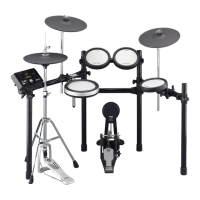
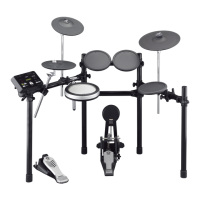



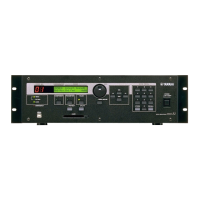

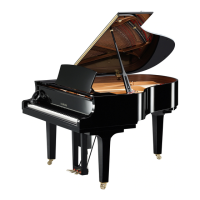
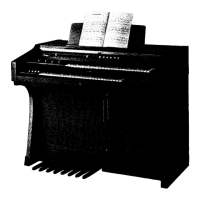



